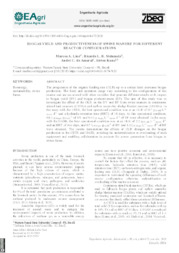Biogas yield and productiveness of swine manure for different reactor configurations.
Biogas yield and productiveness of swine manure for different reactor configurations.
Authorship: LINS, M. A.; STEINMETZ, R. L. R.; AMARAL, A. C. do; KUNZ, A.
Summary: Abstract: The progression of the organic loading rate (OLR) up to a certain limit increases biogas production. The limit and operation range vary according to the configuration of the reactor and are associated with other variables that generate different results with respect to biogas yield (BY) and biogas productiveness (BP). The aim of this study was to investigate the effect of the OLR on the BY and BP from swine manure in continuous stirred tank reactors (CSTRs) and upflow anaerobic sludge blanket reactors (UASBs). In the assay with the CSTR, the best operational condition was at an OLR of 0.7 gVS add L−1 reactor d−1 and a hydraulic retention time (HRT) of 18 days. At this operational condition, 0.8 LN biogas gVS add−1 of BY and 0.6 LN biogas L−1 reactor d−1 of BP were obtained. In the assay with the UASB, the best operational condition was at an OLR of 2.2 gVS add L−1 reactor d−1 and an HRT of two days, and 0.7 LN biogas gvs add−1 of BY and 1.6 LN biogas L−1 reactor d−1 of BP were obtained. The results demonstrate the effects of OLR changes on the biogas production in the CSTR and UASB, avoiding the underutilization or overloading of such equipment and enabling collaboration in projects for power generation from biogas in swine farms.
Publication year: 2020
Types of publication: Journal article
Unit: Embrapa Swine & Poultry
Observation
Some of Embrapa's publications are published as ePub files. To read them, use or download one of the following free software options to your computer or mobile device. Android: Google Play Books; IOS: iBooks; Windows and Linux: Calibre.
Access other publications
Access the Agricultural Research Database (BDPA) to consult Embrapa's full library collection and records.
Visit Embrapa Bookstore to purchase books and other publications sold by Embrapa.

